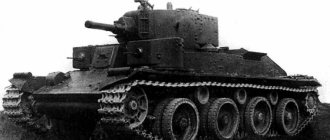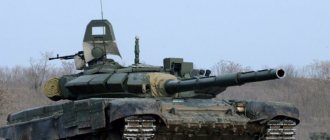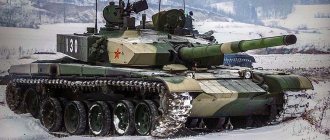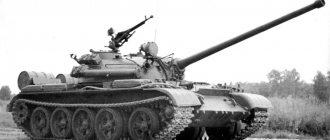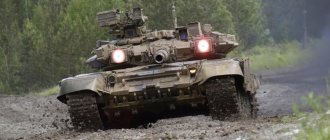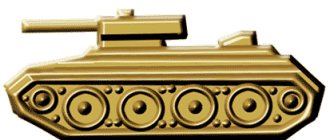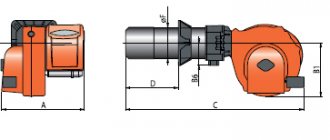Review of video guide T-43 World of Tanks
The T43 tank is controversial. They really wanted to replace the T-34 with 43, but it didn’t go into production; the factories were too busy producing other vehicles. And why? This tank isn't quite as powerful, but its parts are innovations for other tanks. For example, the chassis was used for the production of the T-44. The T-43 played its role, although not at all noticeable.
In the game, the T43 tank occupies a place in the seventh rank of Soviet tanks. “Why” - one might ask. After all, it doesn’t have the speed of the T20, or a gun like the Panther, or even armor like the VK3002DB.
But it only seems so. In reality, all his potential is a little bit of everything. The T-43 has armor, guns, and speed, although not in large quantities.
Modules
Guns
| Lv. | gun | Penetration (mm) | Damage (HP) | Rapid fire (rounds/min) | Spread (m/100m) | Mixing (c) | Weight, kg) | Price() |
| VII | 85 mm D-5T-85BM | 144/194/44 | 180/180/300 | 11.11 | 0.37 | 2.3 | 1850 | 73600 |
| V | 122 mm U-11 | 61/140 | 450/370 | 5.36 | 0.57 | 2.9 | 1600 | 45920 |
| VI | 85 mm S-53 | 126/167/43 | 160/160/280 | 12.5 | 0.42 | 2.3 | 1550 | 62000 |
Towers
| Lv. | Tower | Armor (mm) | Rotation (gr/sec) | Review (m) | Weight, kg) | Price() |
| VI | T-43 arr. 1942 | 80/80/60 | 48 | 360 | 7000 | 12840 |
| VII | T-43 arr. 1943 | 90/90/90 | 46 | 370 | 8400 | 15300 |
Engines
| Lv. | Engine | Power (hp) | Fire probability (%) | Weight, kg) | Price() |
| VI | V-2-34M | 520 | 15 | 750 | 29500 |
| VIII | B-2-44 | 560 | 12 | 750 | 49740 |
| VIII | V-54K | 600 | 12 | 750 | 58000 |
Chassis
| Lv. | Chassis | Max. load (t) | Turning speed (gr/sec) | Rmin | Weight, kg) | Price() |
| VI | T-43 | 34 | 36 | B/2 | 6400 | 11690 |
| VII | T-43 arr. 1943 | 37.3 | 38 | B/2 | 6400 | 17720 |
Radio stations
| Lv. | Radio station | Communication range (m) | Weight, kg) | Price() |
| IV | 9Р | 325 | 80 | 1980 |
| VIII | 9RM | 525 | 100 | 24240 |
Equipment, gear and ammunition:
List of equipment that can be installed on the T-43:
Equipment for the T-43 tank:
For the Active Action Rammer, Improved Ventilation, and Coated Optics equipment . On the first slot we install complex Rammer equipment, which increases the reload speed by 10% . On the second slot we install complex equipment Improved ventilation, which increases the level of proficiency in the main specialty and additional skills by 5% . On the last slot we install complex equipment Coated optics, which increases the viewing radius by 10% .
For the Ambush Sniper , you need to install the equipment "Improved Ventilation", "Stereo Tube" and "Camouflage Net" . On the first slot we install complex equipment Improved ventilation, which increases the level of proficiency in the main specialty and additional skills by 5% On the second slot we install removable equipment Stereo Tube, which increases the viewing radius 3 seconds after stopping. On the last slot we install the removable equipment Camouflage Network, which reduces the visibility of a stationary tank after stopping after 3 seconds.
Equipment:
List of equipment that can be installed on the T-43:
The equipment should be equipped with a standard set of equipment: Small repair kit , Small first aid kit , Hand fire extinguisher . The fire extinguisher can be replaced with Lend-Lease oil , which will increase engine power by 5% . For tournaments or when there are a lot of credits, you can replace the fire extinguisher with Extra Ration 10% to all skills .
Ammunition:
85 mm D-5T-85BM gun - we’ll take most of the armor-piercing shells, but against more armored enemies it’s worth taking a few premium sub-caliber shells, which will make the game easier. High-explosive fragmentation shells will be useful for us to shoot down the capture of the base and finish off opponents with a small margin of safety. The total ammunition load is 48
shells.
Assembly of equipment, equipment and ammunition - Active actions:
| 40 | 5 | 3 | ||||||
Assembly of equipment, equipment and ammunition - Defense:
| 40 | 5 | 3 | ||||||
Historical reference
Main article
:
History of the T-43
T-43 in testing
The project was developed by the design bureau of plant No. 183 in 1942 on the basis of the T-34 using structural elements of the T-34 tank. By completely reworking the T-34 hull and more compact placement of all components and mechanisms, it was possible to significantly increase the tank's protection (75 mm frontal armor). This significantly increased the tank’s chance of survival on the battlefield, since back in the summer of 1942, after shelling the serial T-34 from captured German guns, it was noted that the T-34 tank was “permeable to the fire of German anti-tank guns at all distances and all angles of actual fire.” " Two experimental T-43 tanks underwent front-line testing as part of the “special tank company No. 100” from August 19 to September 5, 1943. The tanks received from 1 to 11 hits from enemy fire, the armor of the tanks was not penetrated, thus not a single one of the experienced tanks was lost. The T-43 medium tank was recommended for adoption, but was not mass-produced due to the impossibility of further modernization, as well as an increase in weight, which led to a decrease in cross-country ability and cruising range. However, developments on the T-43 were used both in the creation of other promising models of medium tanks (such as the T-44), and in the modernization of the T-34, ultimately leading to the appearance of the T-34-85 - the turret was taken with minor changes specifically from the T-43.
Photos and drawings
Crew:
- Crew commander;
- Gunner;
- Driver mechanic;
- Loader (Radio Operator).
Learning additional skills for the crew:
Standard crew for Active Actions:
| 1 | 2 | 3 | 4 |
For the first slot, we teach all crew members, except the commander, the “ Repair” , and for the commander the “ Sixth Sense” skill - the “Repair” skill speeds up the repair of damaged modules, and the “Sixth Sense” will allow you to determine whether his tank has been detected by the enemy. Also, all crew members need to learn the additional skill “ Combat Brotherhood” , which will improve the level of proficiency in the specialty - be sure to learn it all at once, preferably used in the second or third slot.
- the Eagle Eye skill , which increases the viewing range.
- For the gunner we learn the skill “ Smooth turret rotation” , which reduces the spread when turning the turret; and the Sniper , which increases the chances of causing damage to modules and crew members.
- For the driver mechanic, we learn the “ Smooth Move” , which reduces the dispersion of the gun in motion; and the Off-Road King , which reduces drag on soft to medium ground when driving.
- For the radio operator we learn the skill Radio Interception , which increases the viewing range; and the Inventor , which increases the communication range of the radio station by 20% .
- For the loader, we learn the skill “Non-contact ammo rack ,” which increases the strength of the ammo rack; and the Radio Interception , which increases viewing range.
Studying skills and abilities of crew members for defense:
| 1 | 2 | 3 | 4 |
For the first slot, we teach all crew members the “ Camouflage” , and for the commander the “ Sixth Sense” skill - the “Camouflage” skill will reduce the overall visibility of the tank, and the “Sixth Sense” will allow you to determine whether his tank is detected by the enemy. Also, all crew members need to learn an additional skill “ Combat Brotherhood” , which improves the level of proficiency in the specialty, must be studied by everyone at once, preferably used in the second or third slot.
- the Eagle Eye skill , which increases the viewing range.
- For the gunner we learn the skill “ Smooth turret rotation” , which reduces the spread when turning the turret; and the Sniper , which increases the chances of causing damage to modules and crew members.
- For the driver mechanic, we learn the “ Smooth Move” , which reduces the dispersion of the gun in motion; and the Off-Road King , which reduces drag on soft to medium ground when driving.
- For the radio operator we learn the skill Radio Interception , which increases the viewing range; and the Inventor , which increases the communication range of the radio station by 20% .
- For the loader, we learn the skill “Non-contact ammo rack ,” which increases the strength of the ammo rack; and the Radio Interception , which increases viewing range.
More detailed information about the technique:
The T-43 battle tank is universal in all respects, which allows it to be used for different styles. However, with support, the gun’s penetration will not be enough, even against the seventh level, and for the active one, there will be a lack of dynamics and armor. The top gun has one advantage - it has a high rate of fire, which allows you to bring trouble to the enemy. You can also take a land mine cannon, it is not necessary to target weak points with it, but the damage will only be about 100 units. The armor of the vehicle is very thin, and also does not have rational angles of inclination, which is why it is not worth exposing the body to enemy shells.
Bottom line: The T-43 tank will be difficult to use for players who have just started playing the World of tanks game. Is it worth exploring? Yes, because then there are excellent medium tanks.
History of changes:
Update 0.6.1.5
- The cost of repairs has been increased by 10%.
Update 0.6.2.7
- The impact of movement and rotation on spread has been reduced by 9%.
Update 0.6.3.7
- The rate of fire of the 100mm D-10T gun has been increased.
Update 0.7.2
- The cost of tank repairs has been reduced by 10%;
- The cost of researching a tank has changed from 57,285 to 53,000 (from T-34-85) and from 26,520 to 22,200 (from KV-13);
- The cost of the tank changed from 1,305,300 to 1,355,000.
Update 0.7.3
- Fixed tank damage model.
Update 0.7.4
- Fixed the inability to obtain “elite” status in some cases.
Update 0.7.5
- Due to the rebalancing of battle levels, the tank parameters have been changed: the rotation speed of the stock chassis has been reduced by 1 degree/sec;
- the stock chassis has increased firing spread when moving by 4%;
- the stock chassis has increased firing spread when turning by 4%;
- the top-end chassis has a reduced rotation speed by 2 degrees/sec;
- the stock chassis has an increased firing dispersion when moving by 4.7%;
- the stock chassis has increased firing spread when turning by 4.7%;
- The 100mm D10T gun was removed. As compensation, an 85mm D-5T-85BM gun and a new V-54K engine were installed;
- the stock tower's viewing radius has been increased by 10 m;
- the first turret's rotation speed has been reduced by 1 degree/sec;
- the top turret has an increased viewing radius by 20 m;
- in the top turret of the 85mm ZiS S-53 gun, the aiming time was reduced by 19%;
- in the top turret of the 85mm ZiS S-53 gun, the reload time was reduced by 4%;
- in the top turret of the 85mm D5T-85BM gun, the aiming time was reduced by 19%;
- in the top turret of the 85mm D5T-85BM gun, the reload time was reduced by 7%;
- in the top turret of the 122mm U-11 gun, the reload time was reduced by 1.9%;
- For the 85mm D5T-85BM gun, the ammunition capacity was reduced by 12 rounds.
Update 0.8.0
- Reservation of the T-43 turret mod. 1943 changed from 62 mm to 90 mm all around.
Update 0.8.6
- Profitability increased by 10%.
Update 0.9.15
- The tank has been redesigned with a new visual quality.
In the shadow of the "thirty-four" are Alexander Morozov's T-43 and T-44 tanks
The T-44 tank was not produced in such quantities as the BT, did not go through the entire war, like the legendary "thirty-four", did not become the basis of the post-war armored forces, like the T-54/55, but, undoubtedly, played a significant role in the development of domestic and world tank building.
By 1942, the fire and armor superiority that the new Soviet tanks had over the German ones in the initial period of the war had come to naught.
The Germans actively used new ammunition for tank and anti-tank guns, modernized medium tanks appeared, and finally heavy Tigers.
In addition, other alarming news began to arrive from the front. Units reported that the maneuverability and mobility of Soviet tanks had dropped noticeably, and their maximum speed was considered insufficient.
There were also complaints from units about poor build quality, frequent accidents and breakdowns of tanks. It must be admitted that there were reasons for this.
Experimental tank T-43/76 (right) and T-34/76 (left) with a cast hexagonal turret. Noteworthy are the similarity of hull shapes, the absence of a machine gun in a ball mount and the same driver's hatches (for the T-43/76, moved to the left side of the front plate)
Fight for quantity
If before the start of the war the production of T-34 medium tanks was carried out at well-equipped factories No. 183 in Kharkov and STZ in Stalingrad, then their evacuation to the Urals and the loss of many factories supplying components and materials created enormous difficulties for the high-quality production of tanks.
However, the leadership of the People's Commissariat of Tank Industry (NKTP), formed on September 12, 1941, in accordance with the decision of the State Defense Committee (GKO), persistently demanded an increase in the number of tanks produced.
The designers of the Kharkov tank KB-520 (A. Morozov became its leader after Koshkin’s death in 1940), evacuated along with plant No. 183, were thrown into the struggle to improve the production technology of the T-34, to save non-ferrous metals, rubber, armor steel, and even electrical wires.
This work took all the strength of a small team, which consisted of only 130 designers.
Naturally, in such harsh conditions of the struggle for the quantity and quality of produced tanks inevitably decreased, and the inherent shortcomings of the "thirty-four" became more acute - the imperfection of the gearbox (gears were very difficult to change - for example, the effort required to switch from second to third gear was more than 30 kg), low reliability of the V-2 engine (the service life of wartime diesel engines was initially less than 100 hours). In addition, already in December 1941, the military demanded to significantly strengthen the armor protection of the T-34 with a minimal increase in its weight.
Thickening the armor was supposed to increase the tank's protection against damage from new ammunition that appeared in service with the German army.
Taking into account the requirements of the military, A. Morozov instructed a group of designers to carry out the design development of an improved “thirty-four”.
The project was based on the following provisions: while maintaining the main mechanisms and components of the T-34 tank and limiting the weight of the vehicle to 35 tons, sharply increase the thickness of the armor - from 45 mm to 75 mm (due to a denser layout and the elimination of the fourth crew member). It was planned to implement the design reserve accumulated by the design bureau back in 1940 during the development of the T-34M tank.
The pre-war design of the T-34M tank provided for significantly strengthening the armor protection of the hull and turret, bringing it to 75 mm and 90 mm, respectively. To compensate for the increased mass of armor, the chassis was radically redesigned - the heavy and bulky spark plug suspension (passed on to the T-34 by inheritance from the Christie tank and BT) was abandoned.
Instead, a torsion bar suspension was adopted, with lightweight, small-diameter road wheels with internal shock absorption.
Reduced by one person and crew (the loader was abandoned). At the end of 1940, the Zhdanov plant even produced armor plates for five sets of T-34M hulls.
However, the large amount of work to prepare for mass production of the T-34 led to the fact that work on the T-34M tank was suspended. The project for an improved T-34 was submitted to the NKTP in February 1942, but was not approved.
In the difficult military situation of that period, the leadership of the People's Commissariat considered that it was not yet time to deal with a new vehicle, and KB-520 was instructed to continue work on improving the design and production technology of the serial T-34.
New T-43 tank
They returned to the project for a new tank only in the second half of 1942. Legend has it that one day A. Morozov received a personal call from the Supreme Commander-in-Chief, I. Stalin, and in his characteristic manner said: “there is an opinion that now is the time to start working on new tanks,” and hurried the designer.
It was customary to treat the opinion of the leader of all nations as an order, and accordingly the work began to boil with renewed energy.
An experimental T-43 tank with a 75-mm cannon. Visible is the chassis borrowed from the T-34, a three-man cast turret with an extended shoulder strap and a low-profile commander's cupola
The new tank, designated T-43, largely retained the hull shape, engine, transmission and gun of its predecessor. Up to 80% of the parts were unified with the “thirty-four”. The main difference was the enhanced armor.
The thickness of the armor parts of the hull was 75 mm, and the thickness of the turret was up to 90 mm. The housing design has been simplified to improve automatic welding conditions. The machine gun in the ball mount was removed from the front plate, and the driver's hatch was moved to the right side.
On the left, in the bow of the hull, in the armored fence, a fuel tank was placed (the side tanks were removed from the fenders). To provide the crew with the necessary internal space and save weight, the designers, for the first time on a medium tank, used a torsion bar suspension for the road wheels. It was much more compact and lighter than a candle with vertical springs.
The tank received a new enlarged three-man cast turret with a commander's cupola and a shoulder strap diameter of 1600 mm. The engine and transmission compartment (MTS) remained virtually unchanged - the engine and transmission were installed the same as on the T-34, with the exception of a new 5-speed gearbox (Gearbox). However, due to the increased mass, the maximum speed and cross-country ability decreased.
As a result, the T-43 had a combat weight of 34.1 tons, an F-34 cannon of 76 mm caliber, two DT machine guns, a V-2 engine with a power of 500 hp, a specific power of 14.65 hp/t, armor – 75 mm (located at angles of 54 degrees and 52 degrees), crew of four people, maximum speed – 48.3 km/h.
Since March 1943, prototypes of the T-43 underwent various tests, including front-line tests (as part of the “Special Tank Company 100”) and long-range tests (for 3 thousand kilometers).
The turret, as the most complex component of the new tank, was also tested using two “traveling laboratories” - the hulls of the “thirty-four” modified to install the T-43 turret.
Medium tank T-34 with 85 mm - T-34/85
Around the same time (February-March 1943), feverish activity began to rearm Soviet tanks with more powerful artillery systems, initiated by the disappointing results of test shelling of the new German heavy tank PzKpfw VI "Tiger" captured on the Tikhvin Front.
Its armor (100 mm thick) was not penetrated by the tank and anti-tank guns in service with the Red Army. To correct this situation, an attempt was made to install a D-5T 85 mm cannon in the T-43 turret, provided that it accommodated not three, but two crew members.
However, it was not possible to do this within the strictly allotted time frame - before July 5, 1943 (due to the unavailability of the 85 mm gun). However, on July 15, at the height of the fighting on the Kursk Bulge, by order of the State Defense Committee, the T-43 tank (standard) was recommended for adoption by the Soviet army, and before the development of an 85-mm tank gun armed with a 76-mm F- cannon. 34M!.
And at plant No. 183 preparations began for its mass production. The first ten T-43s were supposed to be produced by the end of August 1943, but the production of this series and, in general, the preparation for mass production of the T-43 were soon stopped by order of Joseph Stalin.
What happened? The fact is that the transition of factories to the production of a new tank, although it had much in common with the T-34, would inevitably cause a decrease in production volumes, and this was considered unacceptable on the eve of the planned extensive offensive operations. In his memoirs, A. Morozov cites Stalin’s remark about the T-43: “Comrade Morozov, you made a very good car. But today we already have a good car - the T-34.
Our task now is not to make new tanks, but to improve the combat qualities of the T-34 and increase their production...” In addition, after the Battle of Kursk, there was an urgent need to arm Soviet tanks with a more powerful weapon than the 76 mm cannon.
However, if previously the only possible candidate for re-equipping a medium tank with an 85 mm gun was the T-43, then after testing the “traveling laboratory” from the T-34 hull and the T-43 turret (with a 1600 mm shoulder strap), it became clear that the T-43 had serious competitor.
Indeed, no one can doubt the fact that it is easier and faster to master only a new turret in the series, and not an entire tank. As a result, a modified "thirty-four" - T-34/85 with an 85-mm cannon - was developed and adopted by GKO Resolution No. 5020 of January 23, 1944, and the production of the T-43, as mentioned above, was abandoned. However, experimental work on the T-43 continued for some time - so in 1944, another experimental T-43 was built with reinforced weapons - an 85-mm D-5 cannon in a new turret.
An experimental T-44 tank with an 85-mm D-5T cannon. A rectangular turret is visible above the driver's hatch with an inspection hatch
After the failure of the T-43 project, which was essentially a deep modernization of the T-34, it became clear to A. Morozov that the design of the new vehicle should have significant reserves for its further development, and the basis for creating a more advanced tank could be improving its layout.
A. Morozov believed that it was possible to significantly increase the space of the fighting compartment by refusing to place the engine and transmission in the rear of the new tank or by a more dense layout of the engine unit and the compartment as a whole.
Back in the spring of 1943, the MTO KB-520 group proposed a scheme for compacting the layout of the T-34 tank by placing the engine across the power compartment (in fairness, it should be noted that this option for the engine location was proposed by Koshkin in 1940 for the T-34M tank).
The creation of a new tank was actively supported by the People's Commissar of the NKTP V. Malyshev, thanks to whom an order for its construction was opened, but also quite strict deadlines were set for readiness for factory field tests (they were supposed to be carried out no later than January 10, 1944).
The design of the new tank was undertaken by designers V. Volkov, M. Kizin, M. Nabutovsky, M. Tarshinov, N. Chistyakov under the direct supervision of A. Morozov. The tank received the designation T-44 and was designed for the installation of guns of caliber from 85 to 122 mm.
A. Morozov repeatedly emphasized that the T-44 should become a completely new type of vehicle, since it had to remain average in weight, and in terms of armament and armor it had to correspond to the heavy tanks of that time.
The new vehicle featured not only a transverse engine arrangement, but also a whole series of other technical innovations, which, if introduced individually, on different tanks, would not have given a noticeable effect, but together they made the T-44 design one that determined the development of the Russian military for decades. armored vehicles.
The first prototype of the T-44 was ready ahead of schedule - by January 1, 1944. Its tests also took place in January and were generally successful. During the testing period, the tank covered more than 1,100 km without serious breakdowns. The shelling of its armored hull from a captured German anti-tank gun PaK 40, 75 mm caliber, showed that its front part was not penetrated from distances of more than 300 m, but from distances of more than 700 m by shells from the 88-mm gun of the PzKpfw VI "Tiger" tank. However, it was decided to increase the thickness of the side armor to 75 mm, and the turret armor to 90 mm.
An experimental T-44 tank with a 122 mm D-25 cannon with an enlarged turret. The driver's cupola is visible
Experimental T-44 tank with 85-mm D-5T cannon
In February 1944, two experimental T-44s were produced, armed respectively with an 85 mm D-5T cannon and a 122 mm D-25T-44 cannon (tanks with an 85 mm cannon were to become conventional - “linear”, and with a 122 mm cannon - artillery reinforcement tanks), which differed in the size and configuration of the towers.
They were tested together with the T-34 and the captured PzKpfw V Panther tank in February-March 1944 and again demonstrated the reliability of their mechanisms and components. The T-44 was lighter than both of these models, and its armor protection in the frontal part was no worse than that of the Panther, which was more of a heavy tank, although in Germany it was considered medium.
At the same time, the T-44’s armament corresponded to the level of the Soviet IS heavy tank and the German “Tiger” and could be further strengthened in the future with a new turret.
Tanks T-44-122 and T-V "Panther" in comparative tests
The width of the T-44 hull was chosen to fit a turret with a service circle of 1800 mm, the length was almost similar to the length of the T-34 hull, and the height was reduced as much as possible and amounted to only 830 mm at the front and 965 mm at the rear.
The upper frontal sheet of the hull was positioned at an angle of 60 degrees. The bulky fender niches were abandoned - the side walls of the hull became vertical. As a result of moving the turret back, space was freed up on the turret sheet for the driver's hatch, where it was placed.
Thus, the driver was provided with excellent visibility in the “stowed” position, and handling improved accordingly. At the same time, we also got rid of the driver being overwhelmed by water when driving along a ford, as was the case on the T-34 (to improve visibility, T-34 drivers usually had to make marches with the hatch open).
On the first experimental vehicles, a rectangular turret was made in the front part above the driver’s seat, which had an inspection hatch. But later, on production vehicles, it was abandoned, and for the mechanic they left only a small viewing slot in the front plate, closed with triplex, and a periscope on the roof of the hull.
The radio operator gunner was excluded from the crew, since due to poor visibility, firing from the front-mounted machine gun was ineffective, and the transmission of radio messages through a crew member reduced the efficiency of communication.
The functions of the radio operator were transferred to the commander, and in the place of the radio operator a fuel tank was installed and ammunition for the gun was placed. Accordingly, the course machine gun in the ball mount also disappeared.
True, on some T-44 tanks produced after 1945, the frontal machine gun was again installed, but rigidly mounted in the front plate, to the right of the driver, who fired from it indirectly.
As mentioned above, in order to increase the volume of the fighting compartment and make it possible to install a turret with a ring diameter of up to 1800 mm (versus 1580 mm for the T-34/85), the length of the MTO was significantly reduced (by installing the engine across the hull - parallel to the gearbox, and also more rational and dense placement of its units).
This made it possible to obtain dimensions for the fighting compartment that allowed the installation of weapons with a caliber of up to 122 mm inclusive, as well as to move the turret back so that its axis of rotation almost coincided with the center of the hull. Here the angular vibrations of the machine were the smallest.
As a result, the accuracy of firing from a tank gun increased and crew fatigue decreased. There was also less likelihood of a long barrel sticking into the ground when moving over rough terrain (the military generally periodically demanded from designers that the gun not extend beyond the dimensions of the body). Most of the ammunition - 44 rounds - was located in a special rack in the right front part of the hull.
Another 16 shots were placed in the turret (12 in the aft niche, 4 on the starboard side), and the last five on the left side of the hull. Machine gun discs were also located in the hull. The 122 mm D-25T-44 gun mounted on the T-44 was significantly different from the conventional D-25-T, which had separate loading (the projectile and propellant charge were loaded into it separately).
Firstly, the barrel length of the D-25T-44 was slightly reduced, and secondly, a special unitary shot was developed for it with a powder charge reduced by approximately 3%.
It was assumed that this would increase the rate of fire of the gun in the tank. The first tests of the T-44 with a 122 mm gun took place in February-March 1944, but ended unsuccessfully: the gun failed and was returned to the factory. In April, tests resumed, but it turned out that an increase in the rate of fire due to unitary loading could not be achieved. On the contrary, the large mass and size of the unitary shot greatly complicated the work of the crew.
Loading the gun, due to its low landing and insufficient “rear segment”, even in a turret with a shoulder strap of 1800 mm, was very difficult.
In the case of separate loading, the rate of fire was only 1 round/min. In addition, the ammunition load of 24,122 mm rounds was completely insufficient for a medium tank and the tasks assigned to it.
The V-2-44 engine with a power of 520 hp was planned for installation on the T-44. (modified diesel V-2IS), equipped with improved fuel equipment. The water and oil radiators were placed horizontally, under the MTO roof, in a uniform air flow.
The roof of the MTO turns on hinges together with the radiators, providing good access to both the engine and its equipment, and to all elements of the transmission.
The engine was powered by three fuel tanks with a total capacity of 420 liters, located in special compartments of the engine bulkhead. The height of the MTO was further reduced by moving the air cleaner (of a new type) from the engine camber to the side.
In place of the fan, which on the T-34 protruded beyond the dimensions of the crankcase, a compact flywheel was installed. This made it possible to mount the engine on a low, rigid, but lightweight engine frame.
As a result, the hull height, compared to the T-34/85, decreased by 300 mm. The mechanical power transmission consisted of a guitar, a main clutch, a five-speed gearbox, side clutches with band brakes and final drives.
With the exception of the guitar and gearbox, all units were the same as on the T-34. The chassis had a torsion bar suspension, already tested on the T-43, but the tracks of the new vehicle remained the same as on the T-34; by the way, the “forty-four” became the last Soviet medium tank with ridge-engine tracks.
As already mentioned, as a result of the tests, it turned out that the 122 mm caliber gun is not suitable for the T-44 for a number of reasons.
Therefore, later the third prototype of the T-44 was re-equipped with the 85-mm ZIS-S-53 cannon adopted for the T-34/85 (instead of the 122 mm D-25-44 cannon) and, having received an improved transmission, was successfully tested in March 1944.
In June 1944, the next two copies of the T-44 (reference) were manufactured with the V-2-34M engine and the ZIS-S-53 cannon, which basically repeated the design of the February vehicles, differing slightly from them in some details.
And by August 1944, the “improved” T-44A was ready. The new tank received a solid-cast turret with “improved” protection (the front is 110 mm thick, the side is 80 mm thick), frontal hull armor increased to 90 mm and a planetary transmission.
It was planned to establish production of the T-44 in Kharkov, liberated on August 23, 1943, on the territory of the KhPZ, which had relatively minor damage and which, according to the NKTB, could be restored as soon as possible.
In accordance with the GKO Resolution, tank factory No. 75 was organized here with the task of producing up to 300 T-44 tanks per month.
Plant No. 183 in Nizhny Tagil, evacuated from Kharkov, continued the established production of the T-34/85. To do this, Plant No. 38 was reevacuated to the territory of the KhPZ from Kirov, with equipment and personnel, including the design bureau there, under the leadership of the creator of the SU-76 self-propelled gun M. Shchukin.
Serial tank T-44. The differences from the experimental vehicle are clearly visible - a smooth front plate with a small viewing slit for the driver, a ZIS-S-53 cannon in a new mantlet, a different turret shape.
The driver's round hatch on the turret sheet, caterpillar and rollers are clearly visible - similar to the T-34. In September, work began on assembling the first production T-44A in Kharkov.
The production of tank components was carried out locally, but the hulls and turrets came from UVZ, and diesel engines from ChKZ, which naturally caused constant delays.
In November 1944, the first five T-44A tanks left the workshops of the Kharkov plant, and in December 20 more, which were sent to tank schools.
Since the beginning of 1945, the production of T-44A tanks, carried out in Kharkov under the name “T-44 of the first series,” was largely debugged and began to grow at an increasing pace. Meanwhile, A. Morozov in Nizhny Tagil continued to improve the T-44.
To increase the projectile resistance of the frontal hull plate, the protruding driver's turret was completely eliminated, and at the same time changes were made to its manufacturing technology.
The experimental tank, called the T-44B, was completed on November 20, 1944. In addition to the monolithic front plate, it received a reinforced bottom, a new V-2-44 propulsion system with a cooling and power system, as well as a ZIS-S-53 gun with increased ammunition. Shortly before the new year 1945, the tank was sent to Kubinka (Research Armored Test Site), where it successfully passed State tests.
Tank T-44B
On March 1, its serial production began in Kharkov (T-44 “gross series” or T-44B). According to the NKTP plan, 850 T-44B units were to be manufactured by the end of 1945, with a total order of 1,200 units.
According to some data, before the end of the war, 190 vehicles were produced in Europe, but they did not take part in hostilities, since they were still considered “limitedly suitable” (MP, torsion shafts, final drives did not work reliably).
Until the end of May, T-44s were handed over only to training units, and only in June the first batch of new tanks was shipped to the troops, and in August a tank unit equipped with new vehicles went to the Far East to join the active army. However, they did not take part in the battles.
In total, in 1945, Plant No. 75 produced 880 T-44B tanks, but by the end of 1945 it was decided to stop both work on this tank and its mass production.
However, limited production of the T-44B continued throughout 1946, during which 718 tanks were assembled.
Thus, a total of 1,631 tanks were produced in 1944-1946 (including 8 experimental ones at plant No. 183 in Nizhny Tagil).
It was never put into production and only prototypes remained of the T-44B, already prepared for production, armed with a 100 mm cannon. The development of this vehicle was prompted by the appearance at the end of the war of German tanks and self-propelled guns with significantly enhanced armor protection.
To confidently fight them, the power of the 85 mm cannon, which was armed with Soviet medium tanks, was no longer enough. In 1945, two experimental T-44-100 tanks with the LB-1 cannon were built (LB stands for Lavrentiy Beria, who at that time was the deputy chairman of the State Defense Committee and was in charge of weapons issues).
The sides and chassis of the tank were covered with steel anti-cumulative screens 6 mm thick. The weight of the tank reached 34 tons, that is, it increased by 3 tons compared to the serial T-44. To combat low-flying aircraft, an anti-aircraft machine gun - DShK - was installed on a turret above the loader's hatch.
The gun's ammunition load was 36 rounds. The tests of the tank were generally successful, although the military was confused by the presence of a muzzle brake on the gun barrel, as well as the reduced maneuverability of the T-44-100. As a result, the T-44-100 was not allowed to undergo State testing and work on it was stopped.
This was due not only to their inherent design flaws and the end of hostilities. The main reason was that in 1945, a project for a new medium tank with the same powerful weapons, but superior to the T-44-100 in all other respects, was already ready. This tank was the future T-54.
T-44 baptism of fire
As already mentioned, the T-44 did not have time to get to Europe before the end of the war. Therefore, the “baptism of fire” of the T-44 can be considered 1956, when Soviet units equipped with these tanks were introduced into Hungary to “suppress the anti-government rebellion.”
By the way, in Hungary, the “forty-fours” had to fight with their “progenitor” T-34/85 - the rebels in Budapest captured five “thirty-fours” of the Hungarian People’s Army, which then took part in battles with Soviet units that entered the city.
The armed uprising in Budapest began on October 23, 1956. There was no need to count on help from the Hungarian army; of the 26 thousand personnel of the Hungarian People's Army, half - 12 thousand - supported the rebels. On the evening of the same day, the commander of the Special Corps of Soviet Forces, stationed on Hungarian territory since 1955, received an order to move to Budapest.
Tank T-44B in Budapest, 1956
The 2nd Guards Mechanized Division (commanded by Major General S. Lebedev) was the first to enter the battle on the streets of Budapest, losing 4 tanks and 4 armored personnel carriers during the day.
By the end of October 24, the number of Soviet units that entered Budapest did not exceed one division (about 6 thousand people, 290 tanks, 120 armored personnel carriers and 156 guns). But on the morning of October 25, the 33rd Guards Mechanized Division, transferred from Romania, approached Budapest; it included the 71st Guards Tank Regiment, armed with T-44 tanks.
And by the evening the 128th Guards Rifle Division, which were immediately included in the Special Corps. By this time, rebel resistance had intensified, which was associated with an incident that occurred near the parliament building.
A Soviet officer died here and a tank burned down. An assault on the center of the capital was planned for the morning of October 28. However, on October 29, Soviet troops received a ceasefire order. On October 31, the government of I. Nagy demanded the immediate withdrawal of the Soviet military contingent from Budapest.
This requirement was fulfilled, and by October 31, all Soviet formations and units were concentrated 15-20 km from the capital. On November 1, the Hungarian government announced its withdrawal from the Warsaw Pact, as well as the country's neutrality and the need to withdraw Soviet troops outside the country. The reaction was immediate. The top political leadership of the Warsaw Pact countries decided to provide “military assistance” to Hungary.
On November 4, 1956, the assault on Budapest began - operation codenamed “Whirlwind”. By this time, the rebels had created a defensive belt around the Hungarian capital, reinforced with hundreds of anti-aircraft guns. Outposts with tanks and artillery appeared in settlements adjacent to the city.
The most important objects of the city were occupied by armed detachments, the total number of which reached 50 thousand people. The rebels had about 100 tanks at their disposal. The main role in the street battles in Budapest was played by the 33rd Kherson Red Banner, twice Order of Suvorov, Guards Mechanized Division (it included the 71st Guards Tank Regiment, armed with T-44 tanks), which was reinforced by the 100th Tank Regiment (armed IS-3 tanks).
Early in the morning of November 4, the main forces of the 33rd and 2nd Guards Mechanized Divisions rushed into Budapest and in a day captured the bridges over the Danube and the Budaesh airfield, capturing almost all the rebel tanks, 15 guns and 22 aircraft. Tanks used cannon fire and rams to make passages in the barricades built on the streets of Budapest, making passage for infantry and paratroopers.
The scale of the fighting is evidenced by the fact that on November 5, the assault on the resistance center in the Korvin cinema, in which units of the 33rd Guards Mechanized Division participated, began after an artillery raid in which 170 guns and mortars took part.
From three sides, several dozen tanks were shooting at the surviving firing points. Only in the evening did Soviet troops capture this quarter. By November 11, the defeat of armed detachments in Csepel and Buda ended the fighting in Budapest. The severity of the fighting is evidenced by the fact that the 33rd Guards Mechanized Division alone lost 14 tanks and self-propelled guns (possibly including T-44s from the 71st Guards Tank Regiment), 9 armored personnel carriers, 13 guns, 4 BM-13 installations, 31 cars and 5 motorcycles. After 1956, T-44s did not take part in hostilities (at least, the author does not know about this).
Later, during the aggravation of Soviet-Chinese relations, some of them, along with other obsolete tanks, were transported to the Chinese border in Transbaikalia and Central Asia, where they were used for the construction of bunkers.
In general, the “forty-four” served for quite a long time, having undergone several modernizations during this time. Since 1961, T-44 tanks underwent modernization, which consisted of replacing transmission and chassis units with units of the T-54 tank. They were equipped with a V-54 diesel engine with a power of 520 hp, a modified guitar design, a new main clutch, and a five-speed gearbox with synchronizers, which made it possible to increase the tank’s speed to 57 km/h. Just like on the T-54, two-stage planetary rotation mechanisms (PMP) were mounted.
The vehicle received a pinion engagement of the caterpillar, as a result of which the tracks and the design of the drive and guide wheels became jammed. The hull, turret and armament remained virtually unchanged, except that the gun's ammunition capacity was increased to 61 rounds.
The driver received a night vision device. But the tank did not have an anti-aircraft machine gun. This modernized vehicle received the designation T-44M. In 1963, part of the T-44M was converted into command tanks.
They were equipped with two radio stations, which led to a reduction in ammunition to 46 rounds and the dismantling of the front-mounted machine gun. This vehicle received the designation T-44MK. During the next modernization, carried out in 1966, a two-plane gun stabilizer was installed on the tank, and the power reserve was also increased. This tank became known as the T-44S.
It should be noted that, despite the fundamental technical novelty, according to the recollections of tankers in its final form, the “forty-four” was similar in terms of reliability, maintainability, scope of maintenance and service life to its predecessor T-34/85 - the “workhorse” of tank forces, went through the entire Great Patriotic War from beginning to end.
After the war, most likely for reasons of secrecy, the presence of a new medium tank in the Soviet army was not advertised. The T-44 did not participate in post-war parades (to the fear of former allies), like the heavy IS-3, and it did not often appear on the pages of newspapers and magazines.
Nevertheless, it was he, like the T-34 in its time, that became a notable milestone in the development of world tank building and the basis for the development of Soviet vehicles of the next post-war generation - the T-54, T-55 and T-62.
Sergey Shumilin
Source


